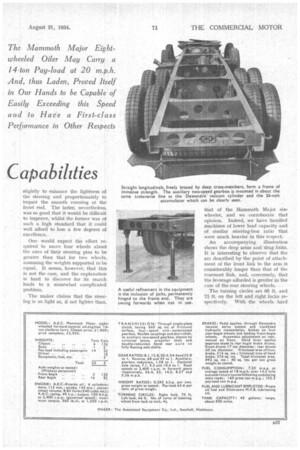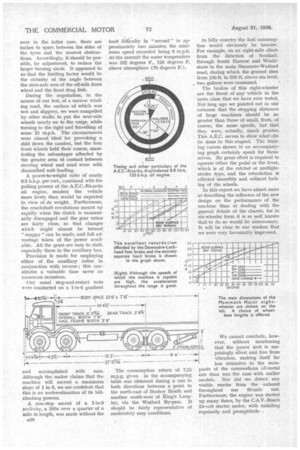A.E C.'s LARGEST OILER
Page 36

Page 37

Page 38

If you've noticed an error in this article please click here to report it so we can fix it.
D t t et
emons ra es s Capabilities
MONG recently introduced types of commercial vehicle, the A.E.C. Mammoth Major eight-wheeler is one of the most outstanding. It is of great technical interest and possesses attractions that no operator who has big loads to transport can afford to ignore.
Apart from its good points as an individual model, however, the desirability of its type is of great importance. Regulations allow the rigid goods vehicle a speed of 20 m.p.h., limit the maximum weight of any vehicle to 22 tons, and the load on any axle to 7i tons.
With all these conditions the double-bogie type of machine can easily be built to comply. Its stability and smooth running, in theory, should be extremely good, and its turning circle and steering effort little, if at all, inferior to those of the six-wheeler, whilst-there are no serious mechanical problems to be solved by the designer in the duplication of the road steerivg wheels, the
layout of the linkage, etc. The
whole matter was discussed at some length in our issue dated June 15 last.
In the machine under consideration we found the theoretical attractions of the type to have been embodied to great practical advantage.
The standard Mammoth Major specification is followed, in the main, throughout the chassis. The replacement of the front axle by a fourwheeled bogie has involved only minor alterations. The well-known A.E.C.-Ricardo six-cylindered oil engine is employed (a petrol unit can be installed if specified) in conjunction with an auxiliary gearbox, and the wheelbase has been adjusted to afford correct weight distribution.
In this connection it should be noted that the vehicle we tested had been loaded in a manner that imposed rather too much weight on the rear and not quite enough on the front. The effect of this would be
slightly to enhance tlie lightness of the steering and proportionately to impair the smooth running at the front end. The latter, nevertheless, was so good that it would be difficult to improve, whilst the former was of such a high standard that it could well afford to lose a few degrees of excellence.
One would expect the effort required to move four wheels about the axes of their steering pins -to be greater than that for two wheels, assuming the weights supported to be equal. It seems, however, that this is not the case, and the explanation is hard to discover for its search leads to a somewhat complicated problem.
The maker claims that the steering is as light as, if not lighter than, that of the :Mammoth Major sixwheeler, and we corroborate that
opinion. Indeed, we have handled machines of lower load capacity and of similar steering, box ratio that were much heavier in this respect.
An accompanying illustration shows the drop arms and drag links.
It is interesting to observe that the arc described by the point of attachment of the front link to the arm is considerably longer than that of the rearmost link, and, conversely, that the leverage afforded is greater in the case of the rear steering wheels.
The turning circles are 66 ft. and 75 ft. on the left and right locks respectively. With the wheels hard over in the latter case, there are inches to spare between the sides of the tyres and the nearest obstructions. Accordingly, it should be possible, by adjustment, to reduce the larger turning circle. It appeared to us that the limiting factor would be the obtusity of the angle between the stub-axle arm of the off-side front wheel and the front drag link.
During the negotiation, in the course of our test, of a narrow winding road, the surface of which was wet and slippery, we were compelled by other traffic to put the near-side wheels nearly on to the verge, while turning to the right and travelling at some 15 m.p.h. The circumstances were almost ideal for provoking a skid down the camber, but the four front wheels held their course, manifesting the advantages afforded by the greater area of contact between steering wheel and road even with diminished unit loading.
A power-to-weight ratio of nearly 0.3 b.h.p. per cwt., combined with the pulling powers of the A.E.C.-Ricardo oil engine, renders the vehicle more lively than would be expected in view, of its weight. Furthermore, the crankshaft revolutions mount up rapidly when the clutch is momentarily disengaged and the gear ratios are fairly close, so that changes which might almost be termed " snappy " can be made, and full advantage taken of the power available. All the gears are easy to shift, especially those in the auxiliary box.
Provision is made for employing either of the auxiliary ratios in conjunction with reverse ; this constitutes a valuable time saver on numerous occasions.
Our usual stop-and-restart tests were conducted on a 1-in-6 gradient
and accomplished with ease. Although the maker claims that the machine will ascend a maximum slope of 1 in 0, we are confident that this is an underestimation of its hillclimbing powers.
A non-stop ascent of a 1-in-9 acclivity, a little over a .quarter of a mile in length, was made without the
1328
least difficulty in " second" in approximately two minutes, the minimum speed recorded being 6 mph. At the summit the water temperature was 192 degrees F., 120 degrees F. above atmosphere (70 degrees F.).
The consumption return of 7.25 m.p.g. given in the accompanying table was obtained during a run in both directions between a point to the north-east of Bushey Heath and another south-west of King's Langley, via the Watford By-pass. It should be fairly representative of moderately easy conditions. In hilly country the fuel consumption would obviously be heavier. For example, on an. eight-mile climb from the direction of Southall, through South Harrow and Wealdstone to the main Stanmore-Watford road, during which the ground rises from 100 ft. to 500 ft. above sea level, two gallons were consumed.
The brakes • of this eight-wheeler are the finest of any vehicle in the same class that we have ever tested. Not long ago we pointed out in our columns that the stopping distances of large machines should be no greater than those of small, from, of course, the same speeds, but that they were, actually, much greaten This A.E.C. serves to show what can be done in this respect. The braking curves shown in an accompanying graph certainly speak for themselves. No great effort is required to operate either the pedal or the lever, which is of the ratchet or multiplestroke type, and the retardation is effected smoothly and without locking of the wheels.
In this report we have aimed more at describing the influence of the new design on the performance of the machine than at dealing with the general details of the chassis, for in six-wheeler form it is so well known that to do so would be unnecessary. It will be clear to our readers that we were very favourably impressed.
We cannot conclude, however, without mentioning that the power unit is surprisingly silent and free from
vibration, making itself far less obtrusive to the occupants of the commodious all-metal cab than was the case with earlier models. Nor did we detect any visible smoke from the exhaust throughout our 60-mile test. Furthermore, the engine was started up many times, by the C.A.V.-Bosch 24-volt starter motor, with unfailing regularity and promptitude




















































































